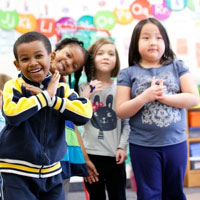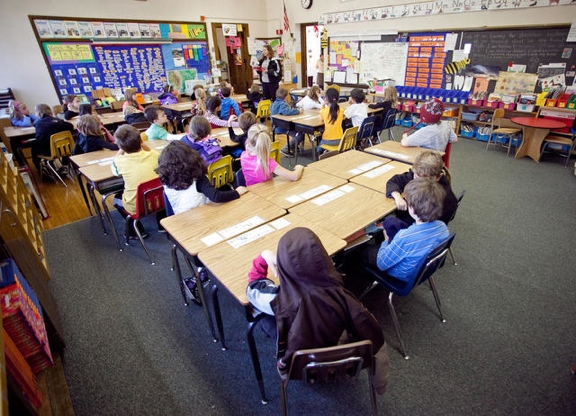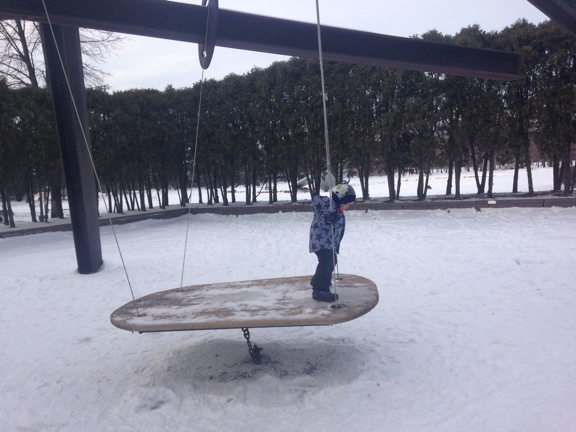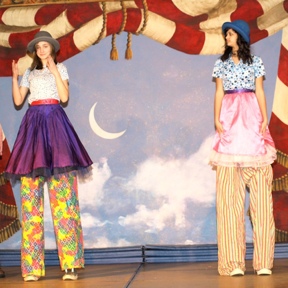 I recently returned to the states from Chengdu with my wife and kids, which was a difficult thing for me to do, because in many ways I love Chengdu. One of the reasons I made the move was to provide a better education for my boys, who are 3 1/2 and 5. This post is about my on-the-ground experience getting my kids situated in the States after spending nearly 14 years in Chengdu.
I recently returned to the states from Chengdu with my wife and kids, which was a difficult thing for me to do, because in many ways I love Chengdu. One of the reasons I made the move was to provide a better education for my boys, who are 3 1/2 and 5. This post is about my on-the-ground experience getting my kids situated in the States after spending nearly 14 years in Chengdu.
We had two very different, very enlightening school visits over the last two months in the US. When I first returned to the states from Chengdu, I was advised to check out the PICA Headstart schools, because they provide pre-school for free. If you weren’t aware, preschool in the US costs big money, and Minnesota (where I have re-located) is one of the more expensive in the Union, coming in at #4 in the most unaffordable states for child daycare.
But then we hear from upper middle class white people that pre-school and day care with an educational bent are absolutely vital for our children, and anyone who doesn’t do what it takes to get their kids in the best possible schools available is basically sentencing the seeds to a future of wage slavery. So we do what we must.
If you thought that Chinese parents were the only ones that have it hard, you thought wrong. The good thing is that we realized, during the second of the two visits that I will discuss here, that most schools in the US are better than any school in China.
But back to PICA. PICA stands for Parents in Community Action and is one of the countless programs available for vulnerable people in the US. What I have found is that, if one slips into the system and goes through the many processes, then the State will provide a living. This is just a preliminary assessment, and I have very little experience with the US welfare state, but if this is the worst the West has to offer, it truly is much more than your average Chinese citizen can expect from their State.
The Safety Net
PICA has a variety of programs, some for battered women, for recovering drug addicts, for new parents, for people with older children who may have behavioral problems (back to this later), and also pre-school and day care for working parents. We went to the PICA school at McKnight, because it is closest to our home.
We saw the children of the poorest people in the city there, being led by the hand, read to, fed, sang to, and cuddled by a diverse band of patient yet obviously overworked and underpaid people. The children were predominantly Black, Latino, Somalian or a mixture thereof. There were very few white kids, I saw barely a handful among the 300 or so kids that were there on that particular day. There was an old Somalian bus driver taking a break from picking up 3-4 year olds cradling a 6 month old baby in one arm, and a 1 year old toddler passed out and drooling on the other. He was ochre, bald and rocking steadily in a room filled with babies left there for the day by harried parents. He smiled at me and went back to whistling through his brilliant white teeth at the black babies in his arms.
A long line of snotty nosed little toddlers went ambling past, holding hands, and looking up at me shyly and with bland trust. A competent, overweight white woman with short red hair led us through on a tour, showing us the lunch dude, a slick black man with a hair net and a long shiny face. She tried to sell us on the place, but really it was a “is what it is” tone that slowly turned our faux eager expressions into nods that said, “we approve, but no way in hell my boys gonna go here”.
And not because people weren’t conscientious, or because the facility was crawling with sly buyers for the circus circuit or grim foremen with shoes to sew; no, the place was fine enough. But there are starting points and there are starting points. I would like my boys to not have to tell a rags to riches story, or a tale of hardship that ends well. Why not start a little higher up the ladder, and see what that does for you?
I mean, PICA at McKnight has buses round up all the kids from the homeless shelters and put them in pre-school classes. They get a couple square meals, and role models that don’t smell of booze. It’s a good thing, and it made me appreciate the USA, because homeless kids in most of the world eat scraps and dream of a place like McKnight. The bottom rung in Minneapolis have a chance in hell, and their parents can bust ass knowing their kids probably won’t have to. It’s that immigrant thang, that American Dream thang, and we saw it up close.
But we didn’t move out of Chengdu to put the boys into a school for the desperate masses.

Aspirational Young Couples
I was at a stand up comedy show at the Corner Bar and the comic was talking about things that annoyed him, as they do, and one of those things was driving behind young couples who slowly drifted through nice neighborhoods dreaming of their future. I laughed real hard at that one, because I was honked at a few times in the days leading up to our second school visit. The second school, Kenwood, is a public school in one of the richest neighborhoods in the city.

Kenwood Neighborhood drifts out from the Walker Art Center, over the only real hill in the city, and down into a winding series of lakes, the Lake of the Isles. It ends where the highway starts, where Whole Foods looms, where Lake Calhoun begins. The houses are incredible. People take to the lake under a cloudless sky lit up by a bright winter sun and skate around, play hockey, toss their beautiful blonde locks about, cross country ski, fast walk in black tights trading insider information. It’s where the local celebrities live. Turns out, Kenwood is in one of the districts that I could call home, thereby ensuring me a spot in the school if I were to apply.
Excellent, says I, and I schedule a visit.
Now what we realized when we entered the school was that, although the neighborhood is really rich, the school itself is a relatively normal public school by Minneapolis standards. It was built in 1908, so there are a few architectural aspects of the building that I liked, such as really wide hallways and wooden floors. The kids come from all over the area, not just the rich kids (who incidentally go to private schools, such as the Blake School nearby) and the teachers were normal people. Not a lot of jewels all over the place or anything like that. The principal is a woman who taught and ran schools on the North side of town, which is in general poorer than south Minneapolis, and therefore, in accordance with American tradition, darker in skin color.
What really got me about the public schools, large or small, predominantly white or mixed, or predominantly colored, was the emphasis on computer learning really early. Kindergarteners have access to computer labs filled with new iMacs, and once they reach 2nd or 3rd grade, they are blogging and doing their homework on Google Docs. I thought that was interesting, but somehow a bit scary. I thought it was a bit much, and soon. But the rest of the nation actually considers the number of computers in the lab as a benchmark for success. There are many academic programs that govern what teachers teach. Slogans and curricula that prepare kids for this and that. The IB formula, which professes to create well-rounded children. Early childhood education, which supposedly gives little kids a head start.
It is therefore very interesting to realize that the US spends more money per student than any other developed nation, has lower test scores, and also a significantly bigger behavior and mental health problem than other nations. About half of the American youth suffer from some sort of mental disorder, according to the State, and that is something that should make you step back and take stock of a scary and sobering reality.
Another thing that made me wonder aloud, “WTF,” was an early screening test for preschoolers, to determine if they are fit for kindergarten. Every child going to public school in Minneapolis must be screened, and the State pushes it hard. Very well-meaning people – such as one man, gay and bouncy and focused on doing the best for everyone, told me that “the screenings are the best, you just HAVE to do it, it’s so good for the kids. They can catch everything early on”.
Catch what?
Speech impediments. Motor skills issues. Reading issues. Mental disorders. Crack habits.
I am 100% convinced that everyone in the Minneapolis school system is absolutely dedicated to the children. There are discounts for pre-school available, great public schools, one of the best Chinese immersion schools in the country, a safety net for everyone, and a very active work force that does its best to get parents involved in the process. Nevertheless, it seemed to me that mental health was the most important issue for a lot of people in the school system.
This feeling that I had, that America in general and the school system in particular suffered from an epidemic of mental disorders, or even worse, a witch hunt for mental disorders, clashed with my hands-on first impressions of the school system.
Compared to the Chinese schools we saw, the American schools seem so much more engaged, humane, thoughtful, and welcoming. There is a personality to every school, a warmth that must foster creativity, because that is what we are known for, and I see most of all a tremendous amount of thought and energy being poured into the question: what to do with our children?
We haven’t made a clear choice yet, but what we learned from our eventual visits to three schools, to a school fair in which all schools in the city were present, and numerous conversation with parents, educators, administrators and random people, is that the US school system is not nearly as horrible as people make it out to be, and not nearly as good as what people here want it to be.
The underbelly stuck with me though, and made me nervous.
Fairy Tales and Magic Gardens
There are times when I feel a sensation, a tingling as if memories from some other life are calling to me wordlessly from the bottom of some deep well, or from a grove I can’t remember having visited. I can almost hear them, almost remember what it was I forgot. I can almost push through the membrane to the location in space time that inspired me, made me believe and wish and hope that one day the sky would be rent open and dragons would pour through. I believe these sensations are the lingering effects of boyhood wonder. When I chase them they disappear.
When I walked into the City of Lakes Waldorf School, I felt them rush back, the stories that swept me away when I was young, the characters from books and dreams I had, the smell of paperbacks and cubby holes and classmates – warm and dank like cereal and fresh toast and the blanket on the couch.

There is a particular type of woman that populates Minnesota (and other locales, I am sure) and that woman is a silver haired one, with bright eyes, incredible intelligence, and a youngish face to go with that silver white mane. That woman represents the story master to me in some ways, more so than the big bearded professor man. I picture small dragons peering out from those thick snow peak locks, and rolling ruby red eyes at me. I always believed silver haired women could turn into something else, that they could cast spells and that they could look at me and know what I was lying about. They seem Irish to me, and therefore green and rolling and surrounded by raging surf.
I left China because I hoped my boys could dream those dreams, picture dragons flitting about a classroom, and let their imaginations do things like turn harmless Northern European women into sorceresses. I wanted them to play freely with a motley colored band of half breeds and thoroughbreds, in vitro seed of LGBT lust, and the thoughtful wan little white girl who cocks her head at the slant to my boy’s eye.
I want them to experience wonder. China doesn’t really make a child wonder much in school, at least not as I see it. And the American public schools could, and might still, but for the time being, until June, we decided on Waldorf.
The rooms are decked in fabrics and wood. The teachers move slowly through the chattering throng like storks picking out stones to avoid. The admissions officer is a Harvard graduate. PhDs abound, theories and philosophies and a circus, theater groups, and Michaelmas coming around next winter … This school, despite my misgivings, offers the best chance for wonder and magic that I have seen so far.
I am of course still applying to the Chinese Immersion School, Yinghua Academy, which is a charter school. And also to two public schools (two per family, based on address, you are guaranteed a seat in your district school), one of them most likely Kenwood, and I have heard of a couple other schools I might try and slip an application to. Because if there is one thing I can’t get enough of it’s choices.
That’s why I left China. Choices.
Even the choice to get screened by zealous Keepers of the Mental Health.
Brilliant story. Good luck with kiddos’ school applications.
Heading back to the states is such a big change in so many ways. The part where you mention 3rd graders using Google Docs really drives that home for me – that’s a world apart from China.
Despite the hardship and sacrifices of getting set up on a new continent (even though it’s your home country), I feel like the value of having your kids be well educated and to be members of a multi-ethnic community will always be with them. China is great for so many things but I’m not convinced that raising kids is one of them. Good luck!
As a native Chengdu Ren and now living in the States for the past 24 years, I have always enjoyed reading your articles/stories. I am sure it was a bit culture shock for you since you had been away for so long; the same goes when I visit China and Chengdu where my parents are. I also thought it was interesting that you noticed that schools emphasize so much on computer technology. I also found it a bit scary as just last week, my 6th grade daughter came home with a brand new Apple ipad that is given to each student by their school. Every middle school and high school student in our school district is given an ipad of their own to use during school year, can you imagine that? My son’s elementary school also has a lot of computer time, each class has 10 ipad for kids to use in a classroom of 18-20 students. I do feel it is a bit too much but just like Chinese parents, American parents also don’t want their children to get behind. It’s myth that people think schools are easy here in the States, maybe in elementary but not in middle school and high school, especially if one wants to get in a good college, kids do work hard here. Anyway, welcome home and I look forward to reading more of your stories and blogs. It will be interesting to read about how your bi-racial children are adjusting here in the States, now that they do not get that much “attention” from friends and strangers like any bi-racial child in China would. I know because I too, have two bi-racial children and while they are just average American children here they get a lot of ‘special” treatment every time they are back in China. They are always a bit confused about their “celebrity” status. Of course, your children are still very young so they may not even notice any differences. I suppose that would be a good thing.
Great writing once again, Sascha! What a transition. With so many years away, we sometimes forget. Minneapolis really is a truly special place.
I especially like the bit about wonder. It’s hard to say much of our understanding as a little kid is effected by wondering about what we don’t know but hear about from our parents, teachers and others. This then in some way transfers to our lives as adults and for me has an effect on how I perceive the world. Is it completely utilitarian, wholly understandable, and tamped down into a corner that can only be explained by those with the proper schooling, viewpoints and authority, hell no. I also want kids to be gifted the ability and space to produce those worlds which can only come from their wonder.